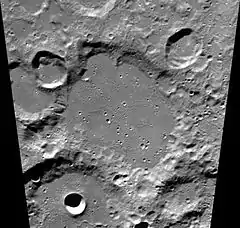Klaproth (crater)
Klaproth is an old lunar impact crater that lies in the rugged southern highlands of the Moon's near side. Due to its location, this crater appears significantly foreshortened when viewed from the Earth. The southern rim of the crater is overlain by the similar-sized crater Casatus, and to the north-northeast lies Blancanus.
 Lunar Orbiter 4 image | |
| Coordinates | 69.7°S 26.0°W |
|---|---|
| Diameter | 119 km |
| Depth | 3.1 km |
| Colongitude | 30° at sunrise |
| Eponym | Martin H. Klaproth |

The outer rim of Klaproth has been deeply eroded, incised, and reshaped by a long history of bombardment. The rim to the north and east remains relatively circular, but the original rim along the western face has been overlain by satellite craters Klaproth G and Klaproth H, and other impacts. To the south the crater Casatus significantly intrudes into the interior floor. The remaining floor has been resurfaced by some material in the past, possibly fluidized ejecta or lava, leaving a level and nearly featureless surface that is marked only by a multitude of tiny craterlets. If this walled-plain once possessed a central peak, it no longer exists.
The crater was named after Martin Heinrich Klaproth, the German chemist and discoverer of Uranium.
Satellite craters
By convention these features are identified on lunar maps by placing the letter on the side of the crater midpoint that is closest to Klaproth.
| Klaproth | Latitude | Longitude | Diameter |
|---|---|---|---|
| A | 68.2° S | 21.6° W | 30 km |
| B | 72.0° S | 24.7° W | 11 km |
| C | 69.1° S | 19.5° W | 8 km |
| D | 70.2° S | 20.4° W | 8 km |
| G | 68.6° S | 31.2° W | 30 km |
| H | 69.4° S | 33.1° W | 41 km |
| L | 70.1° S | 36.5° W | 11 km |
References
- Wood, Chuck (2006-08-05). "Unknown Klaproth". Lunar Photo of the Day. Archived from the original on 2007-09-27. Retrieved 2006-08-05.
- Andersson, L. E.; Whitaker, E. A. (1982). NASA Catalogue of Lunar Nomenclature. NASA RP-1097.
- Blue, Jennifer (July 25, 2007). "Gazetteer of Planetary Nomenclature". USGS. Retrieved 2007-08-05.
- Bussey, B.; Spudis, P. (2004). The Clementine Atlas of the Moon. New York: Cambridge University Press. ISBN 978-0-521-81528-4.
- Cocks, Elijah E.; Cocks, Josiah C. (1995). Who's Who on the Moon: A Biographical Dictionary of Lunar Nomenclature. Tudor Publishers. ISBN 978-0-936389-27-1.
- McDowell, Jonathan (July 15, 2007). "Lunar Nomenclature". Jonathan's Space Report. Retrieved 2007-10-24.
- Menzel, D. H.; Minnaert, M.; Levin, B.; Dollfus, A.; Bell, B. (1971). "Report on Lunar Nomenclature by the Working Group of Commission 17 of the IAU". Space Science Reviews. 12 (2): 136–186. Bibcode:1971SSRv...12..136M. doi:10.1007/BF00171763. S2CID 122125855.
- Moore, Patrick (2001). On the Moon. Sterling Publishing Co. ISBN 978-0-304-35469-6.
- Price, Fred W. (1988). The Moon Observer's Handbook. Cambridge University Press. ISBN 978-0-521-33500-3.
- Rükl, Antonín (1990). Atlas of the Moon. Kalmbach Books. ISBN 978-0-913135-17-4.
- Webb, Rev. T. W. (1962). Celestial Objects for Common Telescopes (6th revised ed.). Dover. ISBN 978-0-486-20917-3.
- Whitaker, Ewen A. (1999). Mapping and Naming the Moon. Cambridge University Press. ISBN 978-0-521-62248-6.
- Wlasuk, Peter T. (2000). Observing the Moon. Springer. ISBN 978-1-85233-193-1.